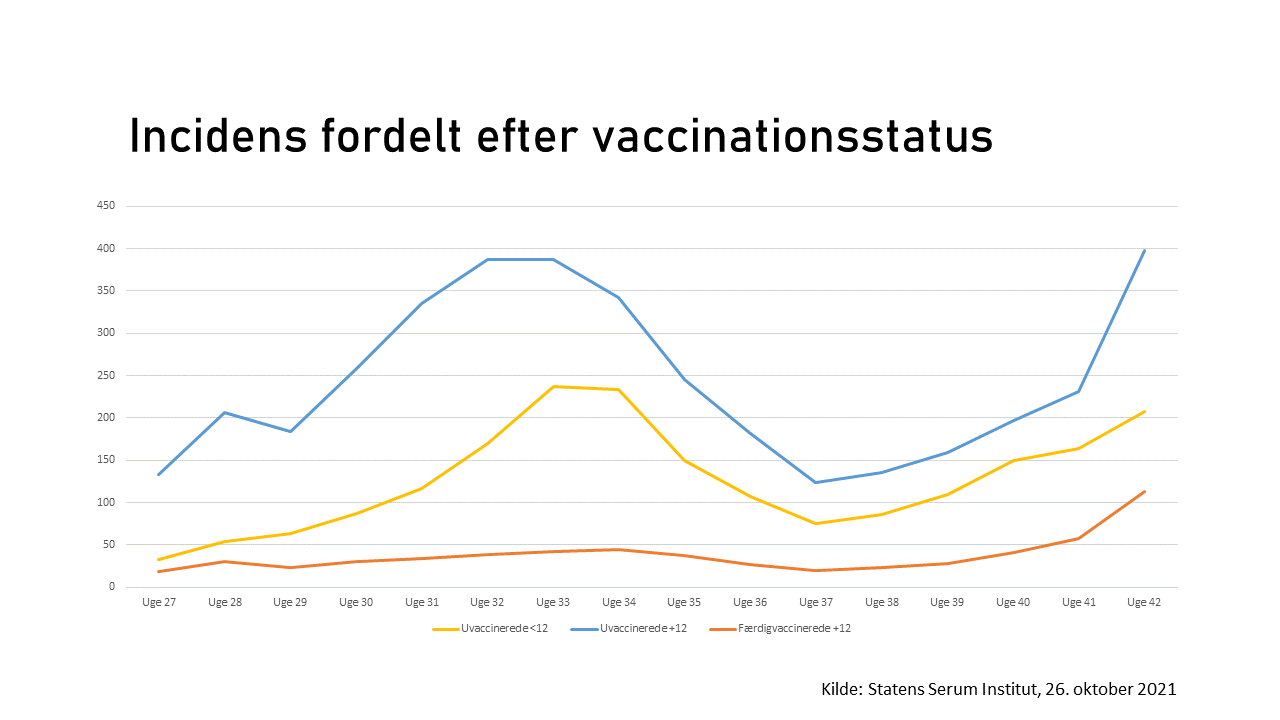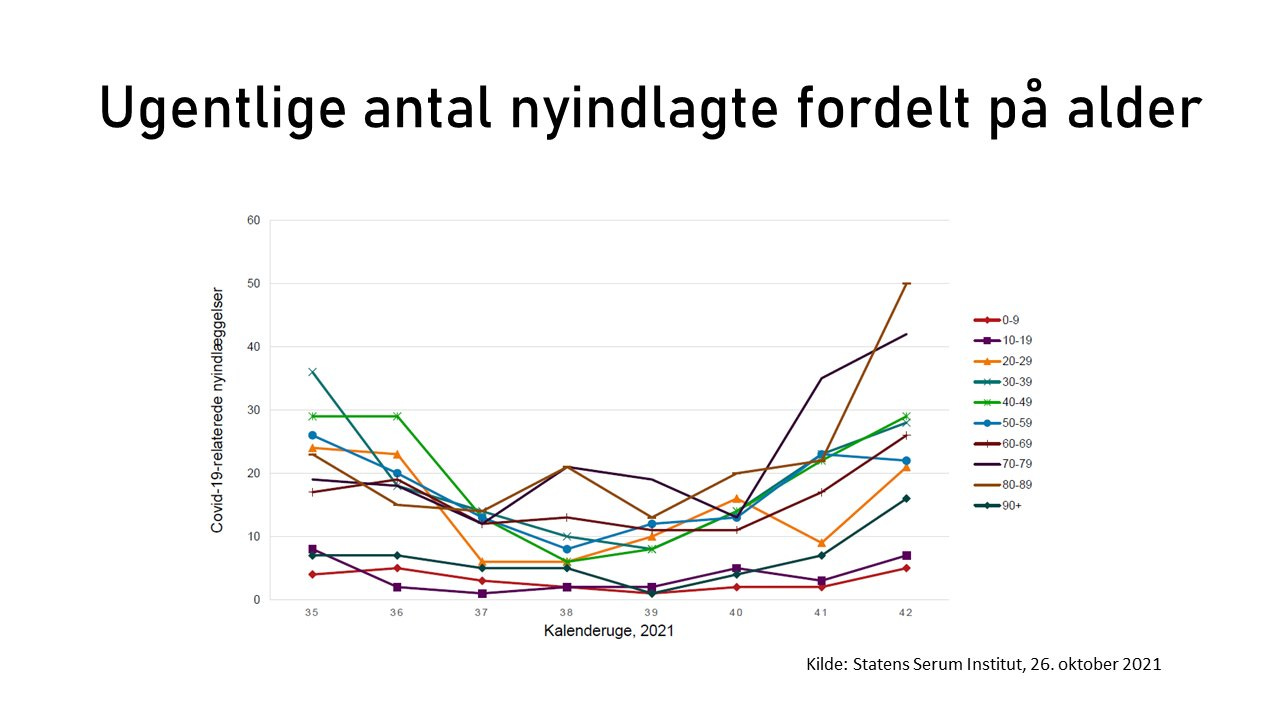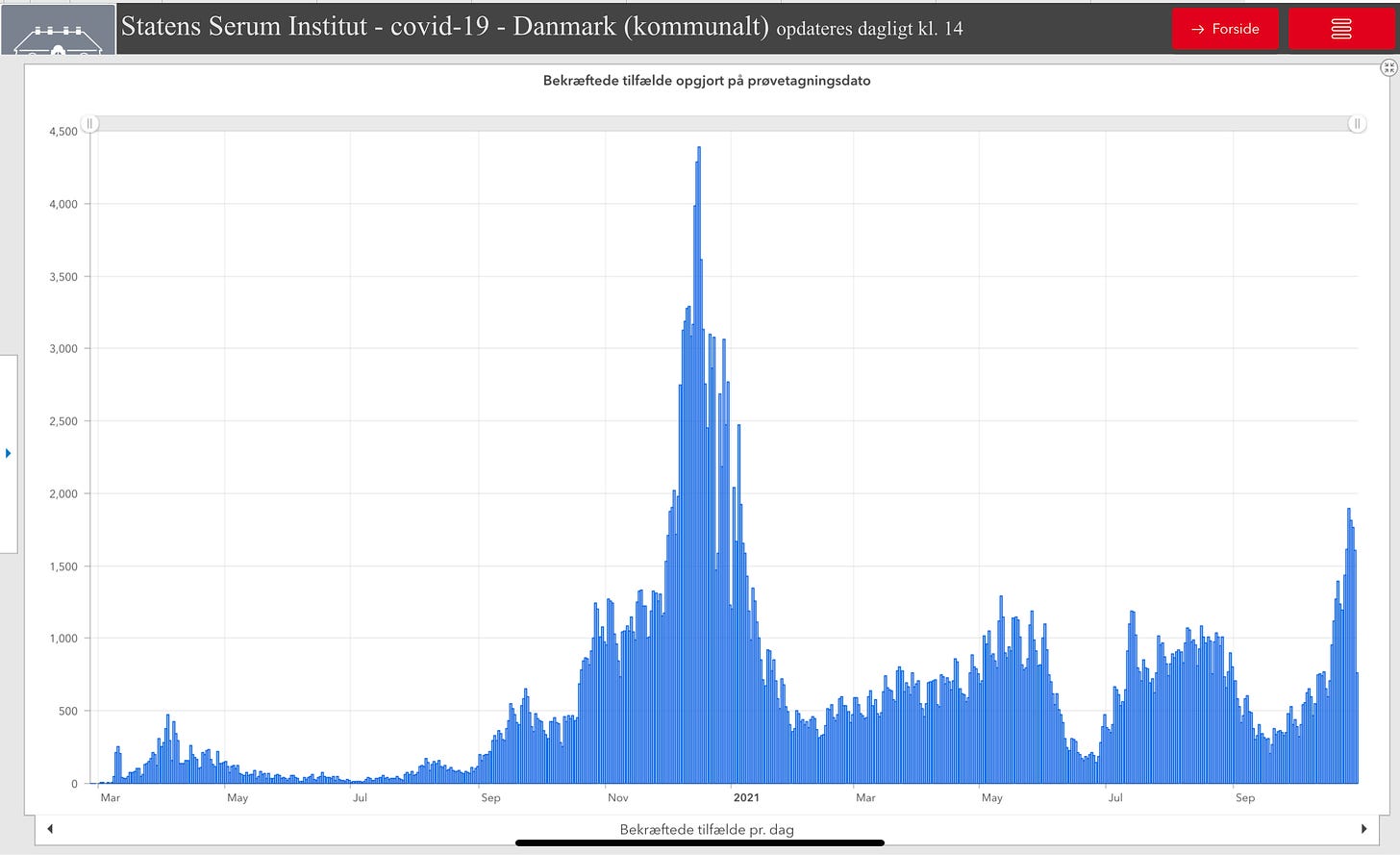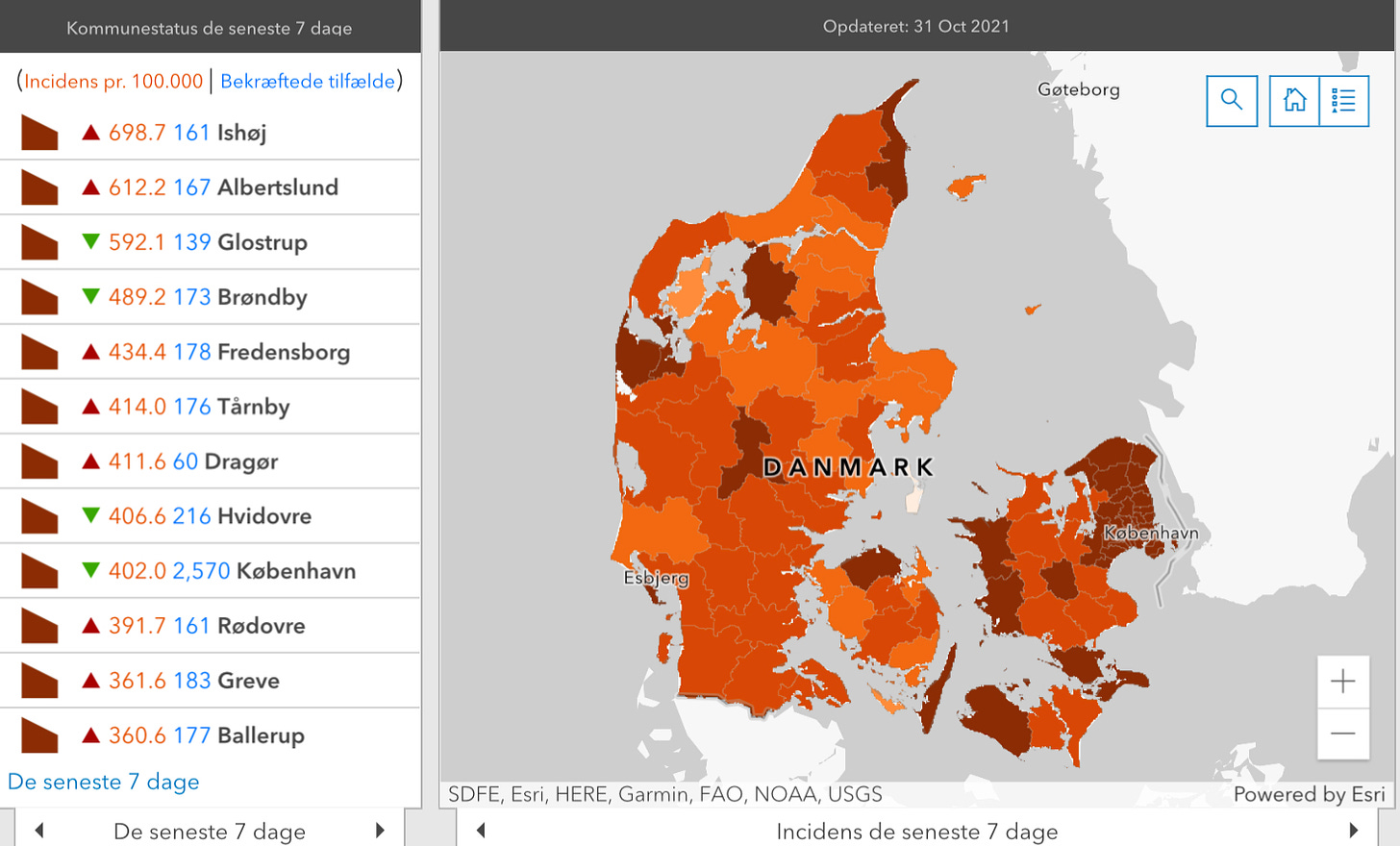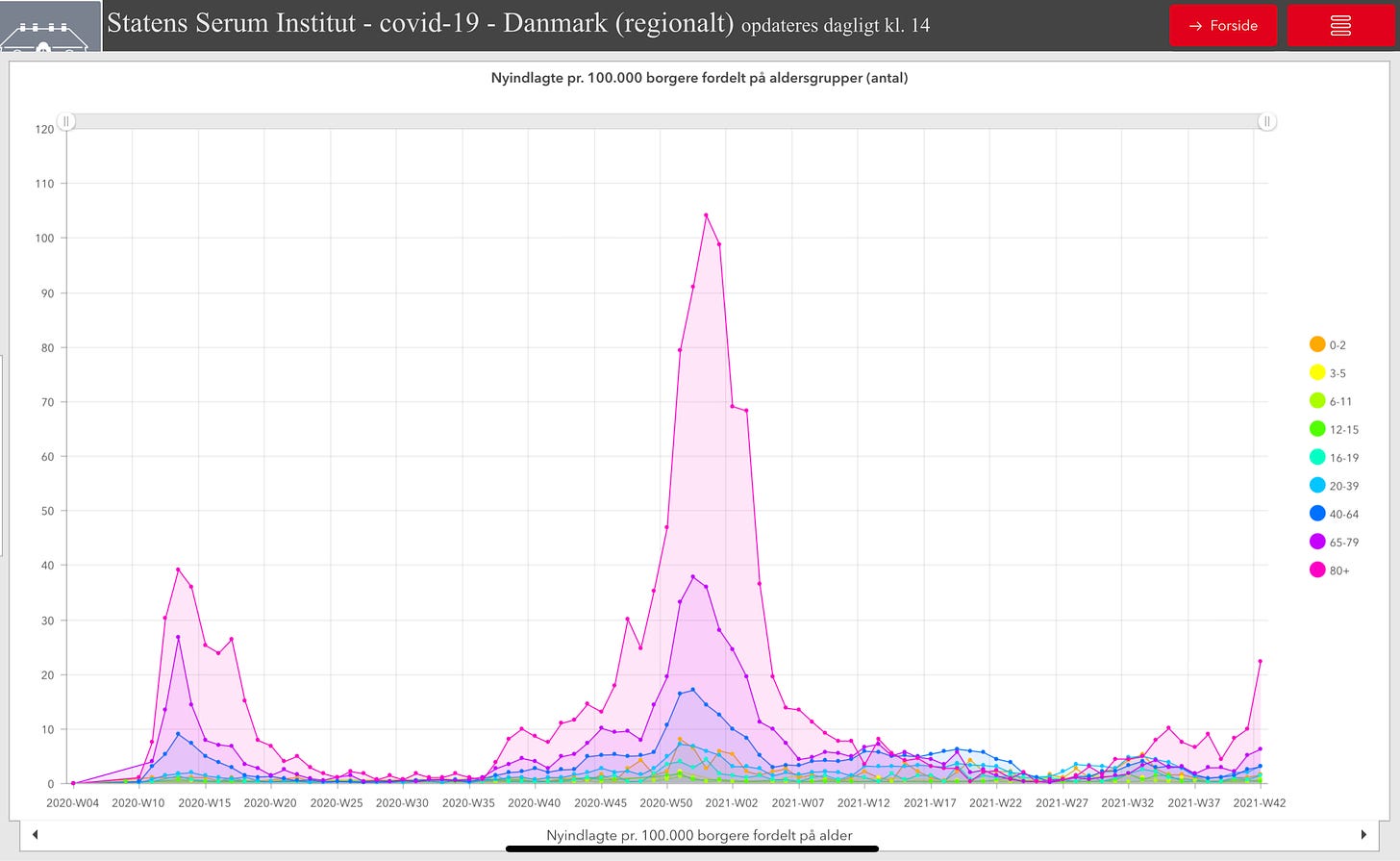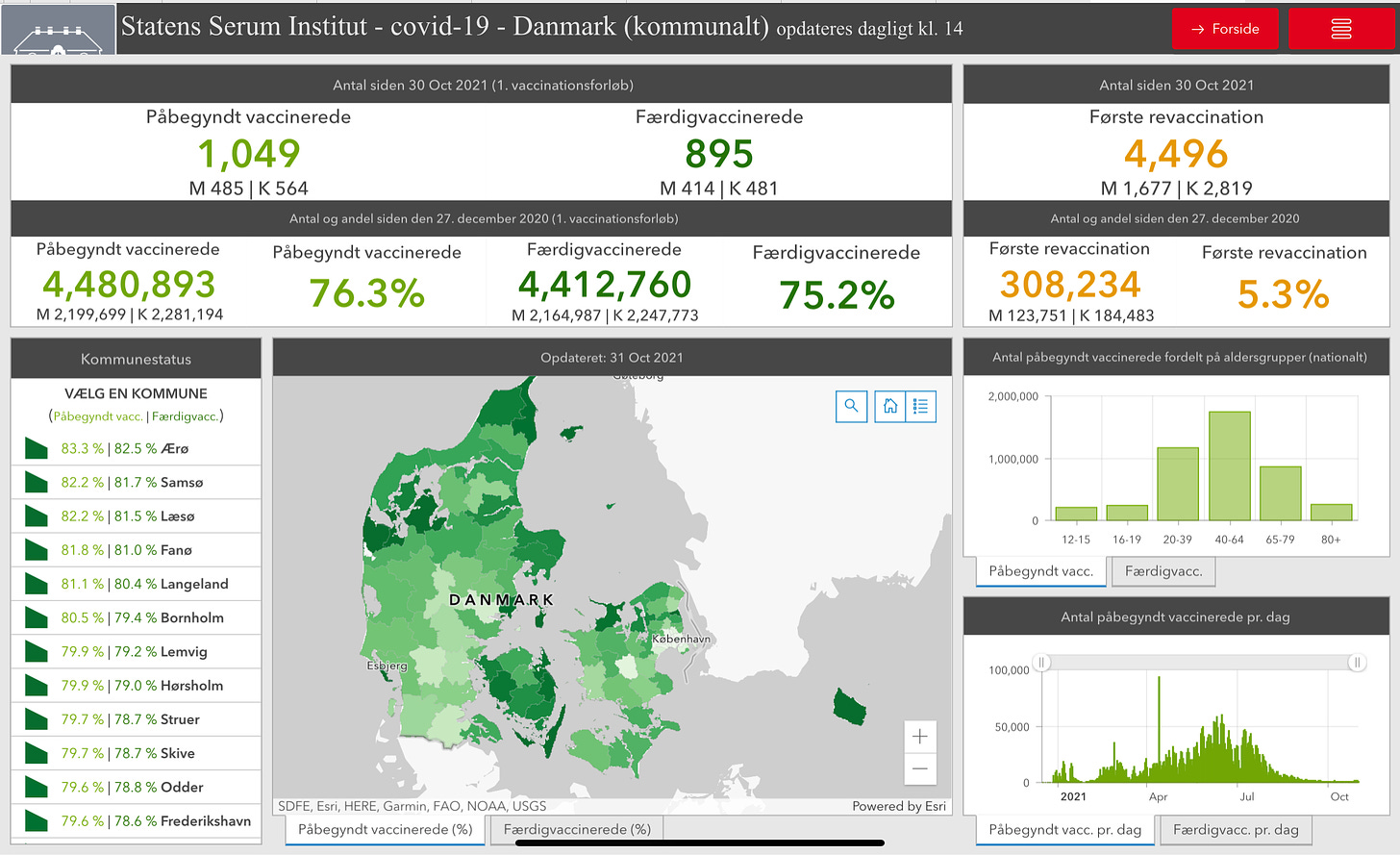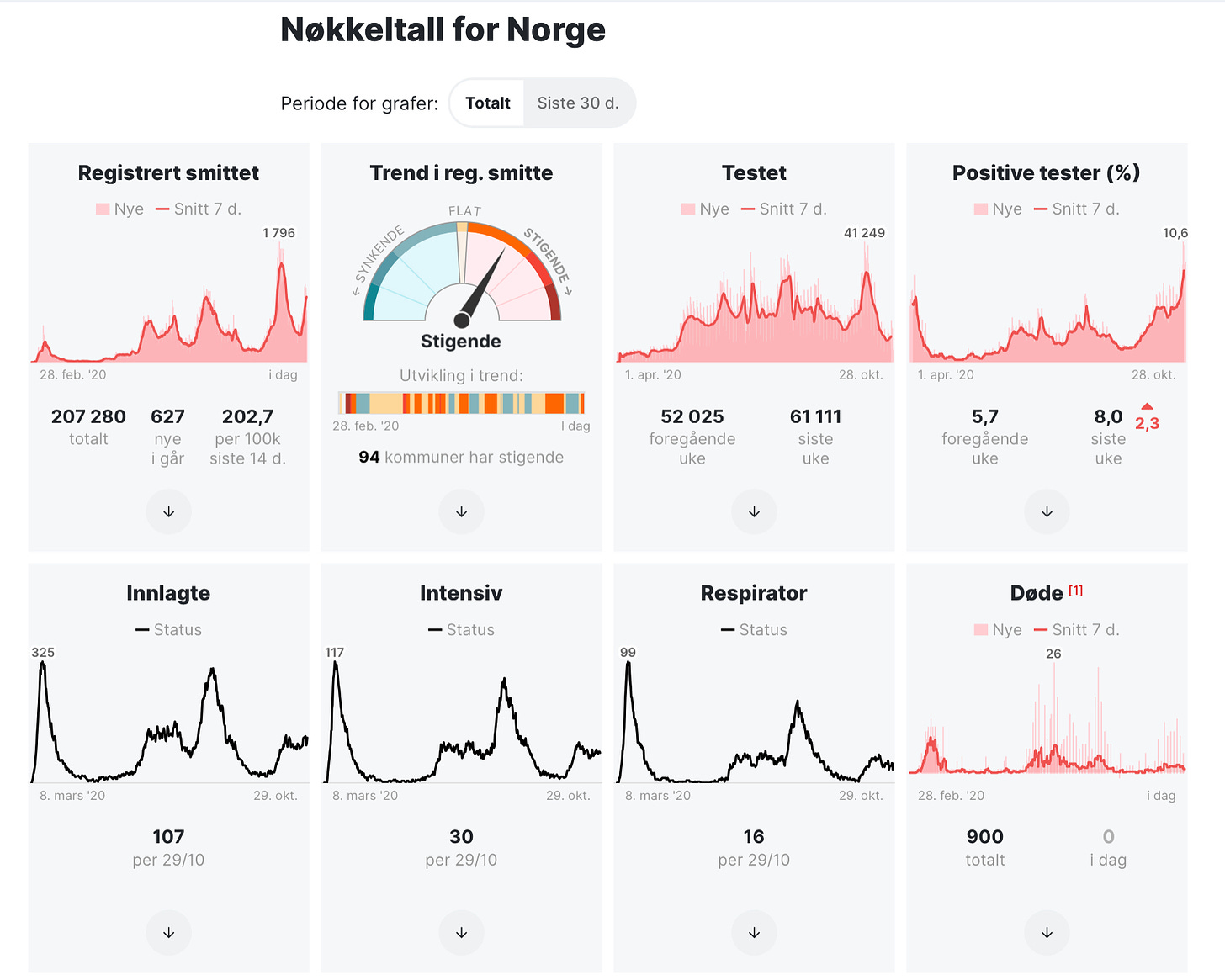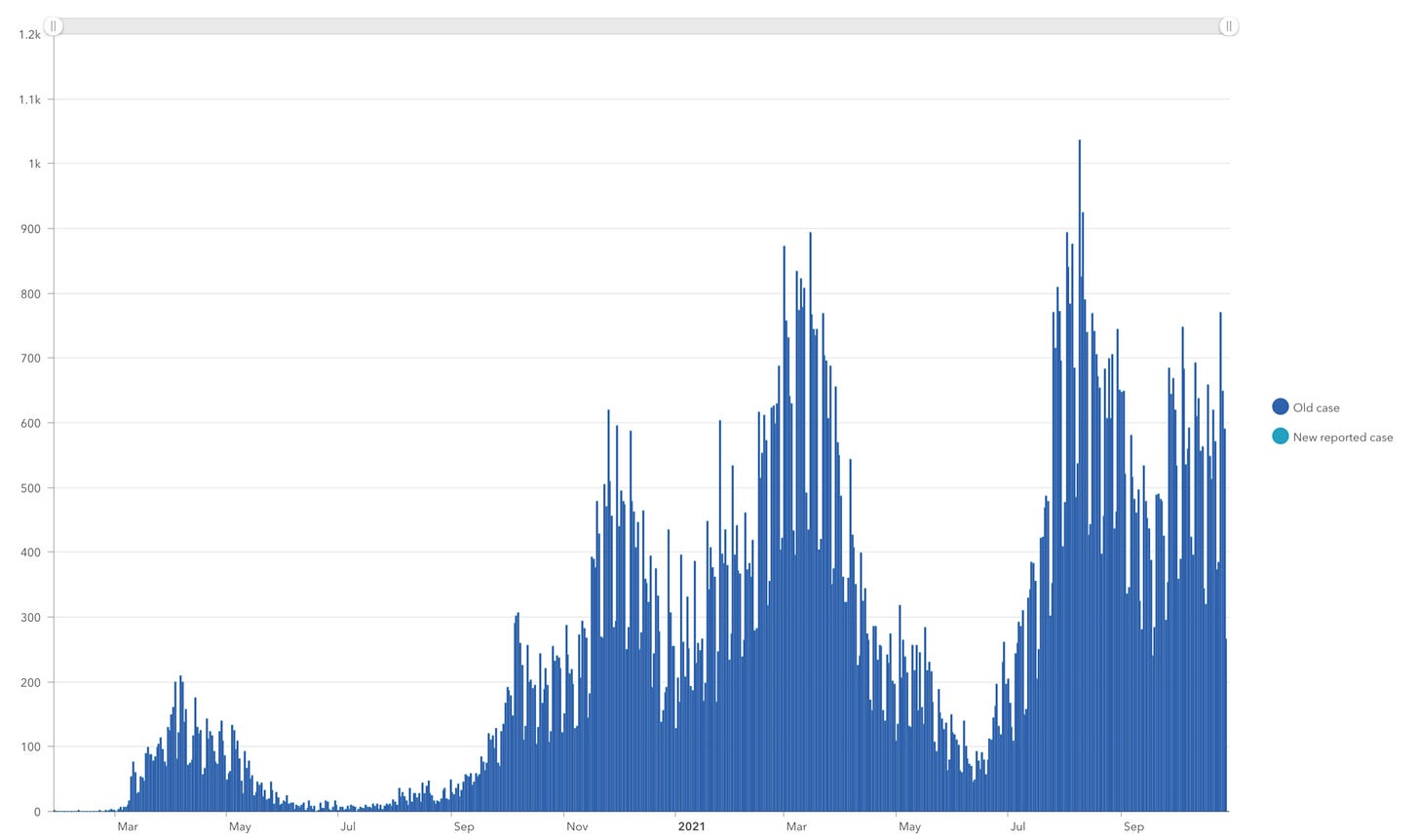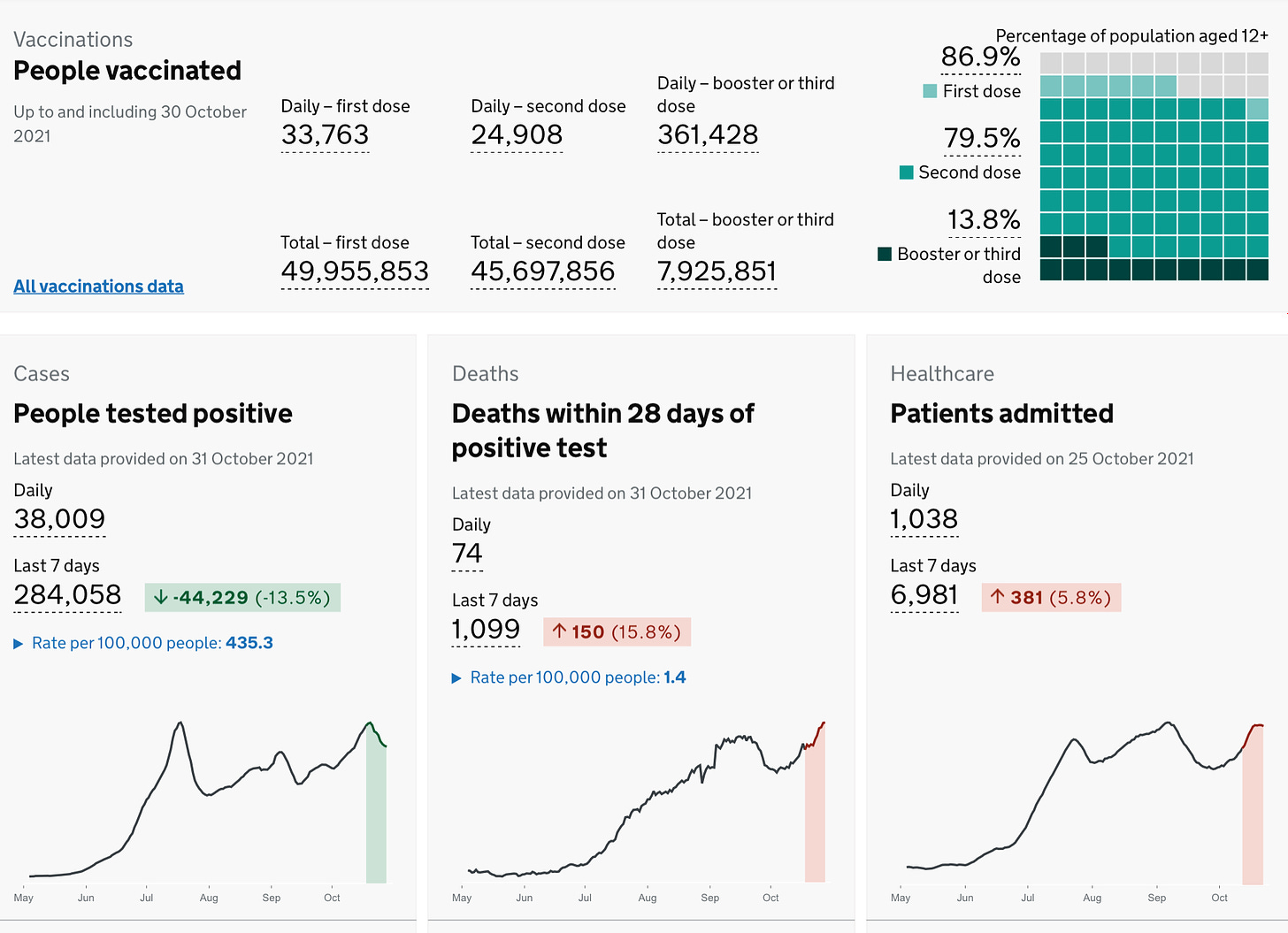Monday Morning News & Notes
Denmark has reintroduced rapid testing as part of an effort to bring down infections
🇩🇰
The Danish government is reintroducing rapid testing including reopening closed testing facilities about a month after winding the whole system down. On Friday, Danish Health Minister Magnus Heunicke announced rapid testing would be brought back with enough capacity to administer 100,000 antigen tests each day. Rapid testing facilities have already opened in the hardest-hit kommunes, Glostrup, Albertslund, and Ishøj. Today more rapid testing sites will come online in Brøndby. Region Hovedstaden says rapid testing sites will also reopen in all 29 Metro Copenhagen municipalities “in the near future.” In Region Syddanmark, rapid testing centers will also open in Vejle, Kolding, and Odense today.
The Danish Agency for Security of Supply says private providers responsible for administering rapid testing have 14 days to get things up and running to be able to do 100,000 rapid tests a day. The agency adds “the capacity can subsequently be further scaled up with 14 days notice.”
It is not just quick tests either. PCR testing is also being beefed up with capacity expanded to 150,000 per day effective last Friday.
Deputy Director of the Capital Region of Denmark's Emergency Preparedness Helene Døssing encourages everyone with symptoms to get tested.
“It is important to be tested so that the infection does not spread, and citizens in municipalities with a high infection pressure now have the opportunity to take both a rapid test and a PCR test close to their homes. If the rapid test is positive, one should always take a PCR test afterwards, because it is more accurate and can also better identify COVID variants.”
On top of this, various health agencies are working with Region Hovedstaden on targeted testing initiatives in some of Metro Copenhagen’s hardest hit areas.
The reintroduction of rapid testing comes about 24 hours removed from Health Minister Magnus Heunicke turning down several mayors who had asked for increased access to rapid testing. Heunicke said then that now was not the time. Such a quick about face is an indication of how serious the situation is. It is also one of very few option left to pursue with Danish political parties not keen on bringing back restrictions or lockdowns. If it doesn’t work to wrestle down the infection curve, then the Danish government will have little choice left other than to bring down the hammer.
-
Almost 4,000 rapid tests were administered on the first day of the reopened quick testing facilities in Metro Copenhagen. Of the nearly 4,000 tests done on Saturday 95 came back positive, equaling a positivity percentage of 2.5%. According to Copenhagen Medical, which runs the quick testing sites, all told, over the entire weekend more than 10,000 people took a rapid COVID test. Of the 6,513 people who had a rapid test on Sunday, there were 148 positive results, also equaling a 2.5% positivity percentage.
-
Politicians leaving the Friday COVID briefing said the idea of bringing back the coronapas requirement for events and indoor venues was tabled. As numbers rise Health Minister Magnus Heunicke convened the situation update.
Socialistisk Folkeparti health spokesperson Kirsten Normann Andersen spoke to DR coming out of the meeting.
“Both the National Board of Health and the Statens Serum Institut point out that the corona passport could have been a good help right now, because it would cause those who have not been vaccinated, to at least be tested. Then we can break the infection curves before they get too wild.”
However, a majority of the parties were not in agreement.
Dansk Folkeparti health spokesperson Liselott Blixt:
“We would like it to be voluntary for the restaurants and companies to take this on. We think it would be good if some of these companies voluntarily said we will require the coronapas.”
Denmark did away with the coronapas requirement entirely on September 10 after phasing out its use to access various events over a number of prior weeks.
-
Denmark’s Health Ministry is waving a warning flag about the state of the pandemic. It says there are about 600 more coronavirus infections each day this year than there were at the same time a year ago. It is not just daily cases either, as it notes, hospital admissions are also rising, with about 80 more patients year over year.
The ministry says the highest number of new infections among those 12 years old and older is among the unvaccinated. It is also unvaccinated people making up the largest portion of hospitalizations.
It adds while infection activity is being seen across all age groups, it is the increase in COVID cases among seniors that is most concerning. This is leading to more and more hospitalizations for Denmark’s oldest populations. Since October 20, between 33 and 52 admissions each day are senior citizens.
The ministry also notes that the epidemic is once again hitting Metro Copenhagen harder than the rest of the country. The capital region has a COVID incidence rate of 338 per 100,000 residents compared to an incidence rate of 200 for the rest of Denmark.
-
Denmark has added 4,987 COVID infections and five coronavirus deaths since its Thursday update. There were 1,784 infections reported on Friday, 1,671 on Saturday, and another 1,532 on Sunday. While corona cases have not risen past last Wednesday’s 1,871, they remain firmly above the 1,000 mark each day. Denmark hasn’t seen this many consecutive days of over 1,000 infections per day since the Alpha variant wave last December and January.
There were 100,554 corona tests in Sunday’s update, of which 91,012 were PCR tests, which equals a positivity percentage of 1.68%.
-
The latest infection wave continues to sink its teeth into Denmark as the map shades deeper and deeper into dark orange and red. The number of kommunes with a COVID incidence rate of over 100 per 100,000 residents has now risen to 75. Of those, 24 municipalities have incidence rates exceeding 200, and nine are over 400. They include Ishøj at 698, Albertslund at 612, and Glostrup at 592.
-
COVID hospitalizations (233) continue to climb (+13) while the number of infected people in an ICU (24) is down slightly (-2) and of those the number on a ventilator (13) also edged downward (-2). The 233 hospitalizations are the highest number of COVID patients since March.
As you can see in the graph below, the number of seniors 80 years old and older being admitted to hospital is rising.
-
The Danish National Health Board says hospitalizations due to COVID have doubled in the last two weeks. The health board says hospitals are facing a growing strain noting most admissions are for other issues, mainly influenza and other respiratory infections like the RS virus. With growing COVID numbers concerns are mounting.
Deputy Director Helene Probst:
“It is to be expected with a completely open society that there will be an infections increase, and thus there will also be an increase in the number of hospital admissions. We have always been concerned about the strain on hospitals into the autumn and now we see the beginning of this development and also expect that the number of hospitalizations will increase further.”
The Sundhedsstyrelsen says it expects in the weeks ahead to see hospital admissions due to the coronavirus to increase between 250-300. It stresses that it is unvaccinated people who are at the absolute highest risk of infection and hospitalization. In the last two weeks, unvaccinated people account for half of all new admissions.
-
On the vaccination front, the number of inoculations underwent the usual Sunday dip with just 6,440 vaccinations administered. While the lion’s share continues to be booster doses, 4,496, it is worth noting that the number of first shots remains above 1,000. Last week, for the first time since September 20, daily vaccinations breached the 1,000 mark, again including a day with more than 1,500 first doses given out.
So far, 76.3% of the total population has one dose, 75.2% have two, and 5.3% have had a 3rd booster shot.
-
The Danish Agency for Patient Safety has reactivated its task force to coordinate efforts to battle the coronavirus surge across Metro Copenhagen. It held its first meeting last Friday. The task force had been put on pause last June as infections plummeted and the urgent need at the time dissipated.
Chief Physician Bente Møller:
“In the Danish Agency for Patient Safety, we have continuously had a close and good dialogue with municipalities. Especially the municipalities where the infection has been high. But the recent development with increasing infection rates means that we and the municipalities believe that there is again a need for an increased coordination of efforts between relevant authorities and the capital municipalities. That is why we are re-establishing the Task Force Hovedstaden.”
The task force will initially concentrate on kommunes in Copenhagen’s west side, where infection rates are rising rapidly.
-
Region Midtjylland says testing demand has risen to the point where testing centers, especially the smaller ones, are seeing growing line-ups. It is now moving testing at its smaller sites to appointment only in order to cut down on long lines. It is now testing by appointment only in Ebeltoft, Rønde, Hammel, Bjerringbro, Struer, Videbæk, Ikast, Brande, Odder, Brædstrup, and Hedensted. The region says larger testing facilities will still take walk-ins for COVID, but it is encouraging people to book an appointment ahead of time if they can.
🇸🇪
Sweden will table its first COVID update of the week on Tuesday.
-
Sweden’s Corona Commission has issued its latest interim report and it lambasts the country’s COVID strategy. It has found that Sweden moved much too slowly in its pandemic response at the cost of a rapidly spreading epidemic and the loss of many lives. It says the country’s “control measures were insufficient to stop or even substantially limit the spread of the virus.” It calls Sweden’s pandemic preparedness “inadequate.”
“Sweden’s system of communicable disease prevention and control was and is decentralized and fragmented in a way that makes it unclear who has overall responsibility when the country is hit by a serious infectious disease.”
The report also blasted major delays in getting robust testing and contact tracing systems off the ground.
“It took far too long, however, to build up a large enough testing capacity. The Commission also finds it remarkable that it was only towards the end of February 2021 that the Public Health Agency changed its recommendation on tracing an infected individual’s contacts back in time from 24 to 48 hours. International experts had been advocating 48 hours as early as the spring of 2020.”
It also blasted the pandemic response from Swedish health authorities for refraining from using, or dismissing outright, strict restrictions, only to introduce them much later. The commission found this undermined public buy in of those restrictions that otherwise would have been much more effective.
“These about-turns occurred largely without any justification being offered on the basis of new knowledge.”
It also raised concerns over data management.
“In several areas, there is a problematic lack of data, making it harder to monitor the pandemic while it is in progress and to satisfactorily evaluate its management when it is over.”
All of this has come at a terrible cost, as Sweden has by far the most coronavirus infections and deaths of any of the Nordic nations. The commission also notes that while the healthcare system was able to adapt on the fly “largely thanks to its employees” it has come “at the price of extreme pressure on staff and of canceled and postponed care. We will therefore live with the consequences of the pandemic for a long time to come.”
The Commission is still carrying out its inquiry and has yet to table its final report.
The report in full can be read in English HERE.
🇳🇴
Norway has added 3,134 infections and had no new corona deaths since its Thursday update.
COVID hospitalizations (107) ICU numbers (30) and the number of people on a ventilator (16) are all unchanged.
To date, 77.98% of Norwegians 12 years old and older have had one vaccine dose and 69.37% have had both doses.
-
It appears a lot of Norwegians dealt with the coronavirus lockdowns by getting down. The Norwegian Institute of Public Health says they are seeing another baby boom. There are 2,037 more children being born in Norway nine months after the Alpha variant wave and subsequent lockdown than in the same time period the year prior. That is a year-over-year increase of about 4.9%.
Medical Birth Register Chief Physician Ferenc Macsali:
“This is interesting, not the least in light of the decline in the number of births annually, from 63,000 to 53,000 births over the course of twelve years. It is surprising that the trend reverses about nine months after Norway’s second big COVID lockdown in the spring of 2020. Whether this trend is only temporary or will continue, we will find out more in a couple of years.”
January of this year was the first month in several years that birth rates have increased in Norway. There were 215 more babies (+4.9%) in January of this year than January of last. In March, the number of newborns really shot up with 376 more births (+8.3%) than in March of 2020. This indicates there was also a baby boom from the country’s first lockdown in the spring of 2020, when coronavirus first swept across the globe.
The numbers had almost nowhere to go but up as the country registered its lowest number of births in the history of the birth registry in the spring of 2020.
🇫🇮
Finland does not report COVID numbers on the weekends, but it registered 572 infections and another four deaths in its Friday report. Numbers covering three days will be tabled later today.
🇪🇺🇬🇧🇦🇲 ✈️
On the travel front, the European Union says that both the United Kingdom and Armenia have signed on to the EU COVID digital certificate. This vaccine passport is accepted in both countries for all EU travelers.
🇬🇧
The United Kingdom is still seeing significant numbers of new infections, 38,009 reported on Sunday along with 74 more deaths, but the numbers over the last seven days have begun to drop. However, both deaths and hospitalizations have increased.
🇺🇸💉
The U.S. Food and Drug Administration has authorized the emergency use of the Pfizer/BioNTech vaccine for children five to 11 years old. The decision, made on Friday, could see the vaccination of young children begin as soon as this week.
The FDA in analyzing the Pfizer application, found the vaccine had an efficacy among young children “comparable” to that of those 16 to 25 years old. The Pfizer vaccine was found to be 90.7% effective in preventing coronavirus infections among young children. Clinical trials involve 3,100 children who received the vaccine “and no serious side effects have been detected in the ongoing study.” The FDA says that in the States, children five to 11 years old make up 39% of all COVID infections in kids under the age of 18.
Children will get two doses of the vaccine taken three weeks apart. The doses will be lower than that given to those 12 years old and older, 10 micrograms versus 30.
With the United States beginning to vaccinate young children, others will follow. Both Health Canada and the European Medicines Agency have similar applications from Pfizer/BioNTech.
🇦🇺 🇺🇸 💉
A joint Australian and American study may have found a way to get people vaccinated without having to have a needle. The researchers are testing a patch about the size of a hockey puck with small needles on it that administers a vaccine fairly painlessly. University of Queensland researchers say it feels “like a good flick on the skin.” At the moment they are testing the vaccine delivery method on mice. Intriguingly, the researchers say that the method may in fact increase the effectiveness of the vaccine.
🇹🇴
The island nation of Tonga recorded its very first coronavirus infection last week. A tourist from New Zealand who flew into the country on Wednesday tested positive and is now in isolation.
🇨🇦
The Canadian Government COVID dashboard has not been updated since Friday.
-
When the United States reopens its land crossings to fully vaccinated travelers from Canada on November 8, U.S. Congressman Brian Higgins said in a press release on Saturday that U.S. border patrol has confirmed with his office that Canadians coming south who have two doses of vaccine will not need to have a negative COVID test to cross the land border crossings. Higgins is co-chair of the U.S. Northern Border Caucus.
It is important to note that a negative COVID test IS required to enter the United States, even for fully vaccinated travelers, if you are flying in from Canada.
-
On the vaccination campaign so far, 29,754,318 1st vaccine doses (77.82% of the total population) have been administered while 28,254,435 people (73.89%) are fully vaccinated.
Of the provinces that report on weekends.
In Ontario over the weekend there were 696 infections reported, of which 453 were among people who were either not vaccinated or who had a single dose. There are 104 infected people in hospital and 133 in an ICU.
Quebec saw 1,102 new infections on Saturday and Sunday, along with three more deaths. There are 250 people in hospital (-4) and 68 in an ICU (-1)
In Saskatchewan there were 259 infections through the weekend and another five fatalities. With 851 total deaths now, the province says October was one of the deadliest months of the entire pandemic.




